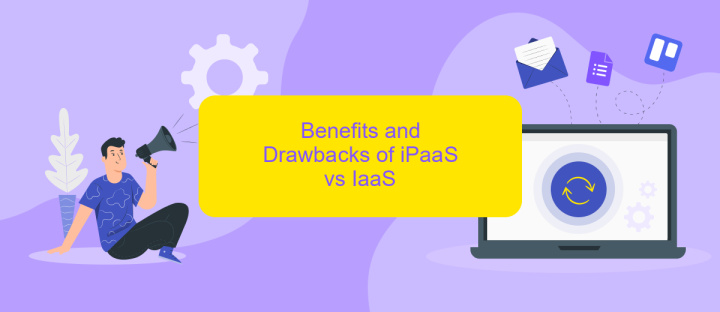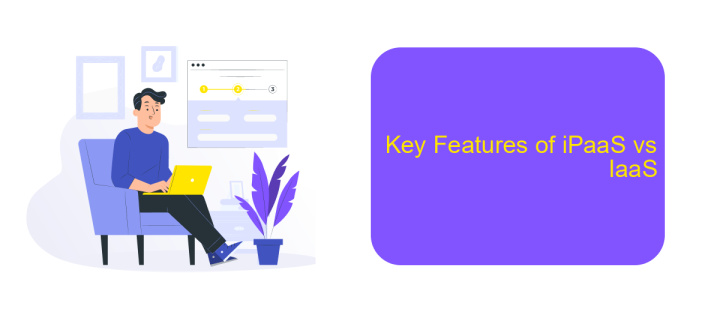iPaaS vs IaaS
In the rapidly evolving landscape of cloud computing, businesses are often faced with the choice between Integration Platform as a Service (iPaaS) and Infrastructure as a Service (IaaS). Understanding the key differences, benefits, and use cases of each can significantly impact an organization's efficiency and scalability. This article delves into the core distinctions between iPaaS and IaaS, helping you make an informed decision.
Introduction
As businesses increasingly rely on digital ecosystems, understanding the differences between Integration Platform as a Service (iPaaS) and Infrastructure as a Service (IaaS) becomes critical. Both iPaaS and IaaS offer unique benefits that cater to different needs within an organization, from streamlining integrations to providing scalable infrastructure.
- iPaaS: Focuses on simplifying the integration of various applications and services. Platforms like ApiX-Drive help automate workflows, reducing manual effort and operational inefficiencies.
- IaaS: Provides virtualized computing resources over the internet, allowing businesses to scale their infrastructure as needed without investing in physical hardware.
Choosing between iPaaS and IaaS depends on your organization's specific requirements. While iPaaS solutions like ApiX-Drive are ideal for seamless integration and automation, IaaS offers flexibility and scalability for your IT infrastructure. Understanding these differences will help you make informed decisions and optimize your business operations.
iPaaS vs IaaS: A Comparative Overview

iPaaS (Integration Platform as a Service) and IaaS (Infrastructure as a Service) cater to different needs within the cloud computing landscape. iPaaS focuses on integrating various software applications and services, streamlining data flow and processes. It is ideal for businesses seeking to connect disparate systems without extensive coding. Platforms like ApiX-Drive offer robust tools for setting up these integrations efficiently, making it easier for organizations to automate workflows and enhance productivity.
On the other hand, IaaS provides virtualized computing resources over the internet, including servers, storage, and networking. It is designed for companies that require scalable and flexible infrastructure without the overhead of managing physical hardware. IaaS is perfect for businesses looking to deploy and manage applications with full control over their environment. While iPaaS simplifies integration, IaaS offers the foundation for building and running those integrated applications, making both services essential but distinct in their roles.
Benefits and Drawbacks of iPaaS vs IaaS

When comparing iPaaS (Integration Platform as a Service) and IaaS (Infrastructure as a Service), it's essential to weigh their benefits and drawbacks to determine which best suits your needs. iPaaS solutions, like ApiX-Drive, offer seamless integration capabilities, enabling businesses to connect various applications effortlessly. On the other hand, IaaS provides scalable infrastructure resources, such as virtual machines and storage, offering flexibility and control over IT environments.
- iPaaS Benefits: Simplifies integration processes, reduces development time, and offers pre-built connectors for various applications.
- iPaaS Drawbacks: Limited control over the underlying infrastructure and potential dependency on the service provider.
- IaaS Benefits: High scalability, full control over infrastructure, and cost-effectiveness for large-scale deployments.
- IaaS Drawbacks: Requires significant management effort, potential for higher costs if not managed properly, and complexity in setup.
Ultimately, the choice between iPaaS and IaaS depends on your specific requirements. If you need to streamline application integrations with minimal effort, iPaaS solutions like ApiX-Drive are ideal. However, if you require extensive control over your IT infrastructure, IaaS may be the better option. Carefully assess your organization's needs to make an informed decision.
Key Features of iPaaS vs IaaS

When comparing iPaaS and IaaS, it's crucial to understand their key features. iPaaS (Integration Platform as a Service) focuses on integrating various applications and services, making it easier for businesses to automate workflows and manage data across different systems. IaaS (Infrastructure as a Service), on the other hand, provides virtualized computing resources over the internet, offering flexibility and scalability for IT infrastructure.
iPaaS platforms, like ApiX-Drive, simplify the process of connecting disparate systems without extensive coding. They offer pre-built connectors, real-time data synchronization, and user-friendly interfaces. IaaS solutions, such as Amazon Web Services (AWS) or Microsoft Azure, provide virtual machines, storage, and networking capabilities, allowing businesses to scale their infrastructure on demand.
- iPaaS Features: Application integration, pre-built connectors, real-time data sync, user-friendly interfaces.
- IaaS Features: Virtual machines, scalable storage, networking capabilities, pay-as-you-go pricing.
While iPaaS is ideal for businesses looking to streamline their integration processes and automate workflows, IaaS is best suited for those needing flexible and scalable infrastructure solutions. Understanding these key features helps in choosing the right platform for your business needs.
Choosing the Right Option for Your Needs
When deciding between iPaaS and IaaS, it's crucial to assess your specific business needs and technical requirements. iPaaS is ideal for organizations looking to integrate various applications and automate workflows seamlessly. For example, services like ApiX-Drive can help streamline these integrations by providing a user-friendly platform to connect different systems without extensive coding knowledge. This can significantly reduce the time and resources spent on manual data entry and improve overall operational efficiency.
On the other hand, IaaS is better suited for businesses that require scalable and flexible infrastructure solutions. This option provides virtualized computing resources over the internet, allowing you to manage and control your IT environment more effectively. IaaS is particularly beneficial for companies experiencing rapid growth or those needing to handle fluctuating workloads. By carefully evaluating your organization's goals and the specific functionalities each service offers, you can make an informed decision that aligns with your strategic objectives.
- Automate the work of an online store or landing
- Empower through integration
- Don't spend money on programmers and integrators
- Save time by automating routine tasks
FAQ
What is the primary difference between iPaaS and IaaS?
When should a business consider using iPaaS?
Can iPaaS replace IaaS in a company's tech stack?
What are some common use cases for iPaaS?
Is it possible to set up integrations and automations without extensive technical knowledge?
Apix-Drive is a universal tool that will quickly streamline any workflow, freeing you from routine and possible financial losses. Try ApiX-Drive in action and see how useful it is for you personally. In the meantime, when you are setting up connections between systems, think about where you are investing your free time, because now you will have much more of it.


